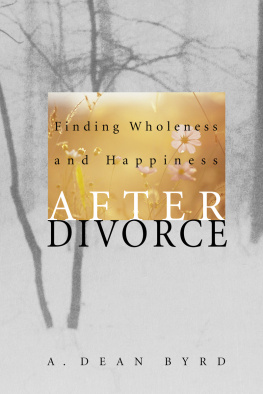Intimate Disconnections
Intimate Disconnections
Divorce and the Romance of Independence in Contemporary Japan
ALLISON ALEXY
The University of Chicago Press
Chicago and London
This book is freely available in an open access digital edition thanks to TOME (Toward an Open Monograph Ecosystem)a collaboration of the Association of American Universities, the Association of University Presses, and the Association of Research Librariesand the generous support of the University of Michigan. Learn more at the TOME website: openmonographs.org.
This work is being made available under the Creative Commons Attribution-Non-Commercial-No Derivatives 4.0 International License (CC BY-NC-ND 4.0). To view a copy of this license, visit https://creativecommons.org/licenses/by-nc-nd/4.0/
The University of Chicago Press, Chicago 60637
The University of Chicago Press, Ltd., London
2020 by The University of Chicago
All rights reserved. No part of this book may be used or reproduced in any manner whatsoever without written permission, except in the case of brief quotations in critical articles and reviews. For more information, contact the University of Chicago Press, 1427 E. 60th St., Chicago, IL 60637.
Published 2020
Printed in the United States of America
29 28 27 26 25 24 23 22 21 20 1 2 3 4 5
ISBN-13: 978-0-226-69965-3 (cloth)
ISBN-13: 978-0-226-70095-3 (paper)
ISBN-13: 978-0-226-70100-4 (e-book)
DOI: https://doi.org/10.7208/chicago/9780226701004.001.0001
Library of Congress Cataloging-in-Publication Data
Names: Alexy, Allison, author.
Title: Intimate disconnections : divorce and the romance of independence in contemporary Japan / Allison Alexy.
Description: Chicago : University of Chicago Press, 2020. | Includes bibliographical references and index.
Identifiers: LCCN 2019045142 | ISBN 9780226699653 (cloth) | ISBN 9780226700953 (paperback) | ISBN 9780226701004 (ebook)
Subjects: LCSH : DivorceJapan. | MarriageJapan.
Classification: LCC HQ 937. A 549 2020 | DDC 306.89dc23
LC record available at https://lccn.loc.gov/2019045142

This paper meets the requirements of ANSI/NISO Z39.48-1992 (Permanence of Paper).
For my mother, Alice Gorham
Contents
All names and identifying details included in this book have been made pseudonymous and have been written in the Japanese order with family names first. In the Japanese language, there are many degrees of familiarity demonstrated by the name you use for someone. Adding -sama to a name, for example, demonstrates your belief that the other person deserves a lot of respect. To a lesser degree, adding -san is often the polite thing to do and is a respectful way to refer to people with whom you have a professional relationship. Usually, -san is added to a persons family name. Although calling someone Tanaka-san could be glossed as Mr. Tanaka, Mrs. Tanaka, or Ms. Tanaka, it does not seem nearly as distancing in Japanese as it does in English, and instead just sounds polite. In more intimate relationships, names often get truncatedMakiko becoming Maki or Ma, for exampleand gendered suffixes can be added. Thus if I am very close friends with a woman named Tanaka Makiko, I might call her Maki-chan or Ma-chan, whereas a stranger would use Tanaka-san or maybe Tanaka-sama.
Following these conventions, although I have changed all names in the book, I represent different kinds of names as a way giving the reader a sense of relationships. Each name is a negotiation that demonstrates the quality of our relationship, and I have maintained these variations in the pseudonyms I am using. Thus, I refer to some people using -san, some by first names, some by nicknames. There is nothing systematic, but the complexity reflects the reality of our relationships. Many people referred to me as Ally, Ally-chan, or Ally-san, which conveniently capture the sounds of both my first and last names.
Anxiety and Freedom
In February 2006, I stepped into an elevator with a middle-aged Japanese man. I had never met him before and we had no connection but, presumably noticing that I did not look Japanese, he struck up a conversation by politely asking why I was in Tokyo. When I explained I was researching divorce and contemporary family change, he responded with a bit of nervous laughter and then said, All the men I know are scared. Were all scared. With little prompting from me, this man volunteered his fear of divorce or, more specifically, his anxiety that his wife would divorce him against his will. He shared these very personal worries even before he introduced himself. Yamaguchi-sans willingness to discuss these fears with a stranger was matched by his assuredness that he wasnt the only one feeling anxious. As scared as Yamaguchi-san was of getting divorced, he was sure other men were in similar positions because divorce was a threat hanging over many of them. As we walked to the nearest train station, he elaborated on his reasons for worrying that his wife might leave him, including their separate hobbies and friend groups, as well as his career that kept him frequently out of their home. Those reasons were no less real for being so common, but divorce was also in the air. A recent legal change stood to provide divorcing wives more financial stability than ever granted before. This seismic shift had made Yamaguchi-san, and other married men like him, suddenly more anxious that their wives would abandon them.
At the same time, other people felt distinctly different emotions in imagining divorce. A middle-aged woman, Nagako-san giggled as she told me about her plans to divorce her husband. She was gleeful at the thought. As a housewife in her midfifties who had supported her husbands career for more than twenty years, Nagako-san embodied stereotypes of gendered labor division in Japanese postwar society. She started narrating a litany of her husbands serious faults a few minutes after I met her. She had been unhappy in the marriage for years but finding email evidence that he had been having a long-term affair was the final strawor almost the final straw. At our first meeting, in a support group organized around family issues, Nagako-san had not yet made legal moves to divorce her husband but was visibly enjoying her plans to do so. In contrast to Yamaguchi-san, for whom divorce portended only looming solitude, Nagako-san veritably exploded with joy imagining all the possibilities divorce could manifest for her. As she described it, divorce symbolized a vital step toward freedom and happiness.
Although divorce has been legal in Japan for centuries, and the divorce rate has risen unsteadily throughout the postwar period, early in the twenty-first century divorce in Japan rapidly became a newly visible and viable option in ways it had never been before. People who had never before thought seriously about divorce were fantasizing about leaving their spouses. Some moved past fantasizing to explicit planning and took concrete steps to end marriages. Others were anxious they might get suddenly abandoned. Such fears and fantasies were reflected in popular media, which were awash in discourse about divorce. Television dramas that centered around divorce garnered surprisingly high ratings especially with older viewers, and newspapers and weekly magazines published how to guides about requesting divorces or navigating the legal process, as well as how not to advice about improving a marriage (Sait 2005). Daily talk shows offered quizzes to measure marital strength and often tailored answers by gender and age, suggesting certain actions, for instance, that older men might take to improve their marriages. Guidebooks gave generalized advice, such as in







 This paper meets the requirements of ANSI/NISO Z39.48-1992 (Permanence of Paper).
This paper meets the requirements of ANSI/NISO Z39.48-1992 (Permanence of Paper).